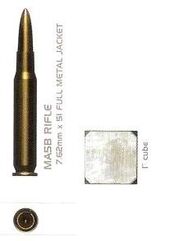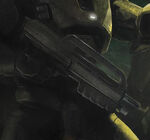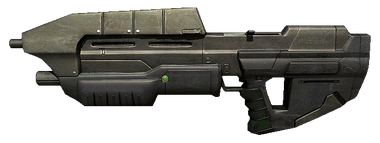
|
This article, MA5B assault rifle, written by Anonymous ONI agent, was voted as the Best Weapon of 2012 in the Fifth Annual Halo Fanon Wikia Awards. |
| This fanfiction article, MA5B assault rifle, was written by Anonymous ONI agent. Please do not edit this fiction without the writer's permission. |
| This is a fanon expansion of a canon element. To see the original canon article, follow the link to Halopedia: MA5B assault rifle. |
| |||||||||||||||||||||||||||||||||||||||||
| [Source] | |||||||||||||||||||||||||||||||||||||||||
The MA5B Individual Combat Weapon System, formally known as the Individual Combat Weapon System, Caliber 7.62 mm, MA5B, was an assault rifle used by the UNSC Marine Corps and Navy throughout most of the Human-Covenant War. It was easily one of the most recognizable and pervasive infantry weapons fielded by the UNSC during humanity's conflict with the Covenant. The MA5B perfected and refined the defining features of the MA5 series rifles introduced by the ubiquitous original MA5, such as the electronic ammunition counter and enhanced electronics suite, while also introducing new features like internal attachments and a larger, redesigned magazine. The massive success of the MA5B would lead to an ultimately even more successful weapon which began to see widespread use towards the end of the war: the MA5C.
Development & Service History[]
The MA5B ICWS was commissioned by the UNSC just following an explosion of violence in the Outer Colonies, which included the uprising on Far Isle in 2492 and the Callisto Incident in 2494. Fearing the worst, the UNSC commissioned a number of weapons in order to update its aging arsenal in preparation for a possible civil war.
Misriah Armory and a handful of other weapons designers churned out a number of prototype weapons. While most were quickly turned down, there were several that showed promise, including the XM392A2, the XM55, the XMA5A2, the XM90A, and the XSRS-99 Series 2. As far as rifles were concerned, the UNSC chose the XMA5A2 as the most promising option, and gave Misriah the go ahead to begin further development of the weapon as the XMA5B.
The newly christened XMA5B was a heavily revamped version of Misriah's MA5 assault rifle that was adopted by the UNSCDF in 2437. The weapon built further upon the principles that led to the success of the original MA5; ruggedness, versatility, and vicious medium to close range firepower. Thanks to remarkably few setbacks in the rest of the development process, the finalized model of the XMA5B, now the MA5B Individual Combat Weapon System, was finished in record time, and in 2506 the UNSC Marine Corps adopted the MA5B to replace the MA5 as their primary service rifle, with the UNSC Navy following suit in 2514. However, the Army and Air Force opted to keep fielding the original MA5 (known as the MA37 by the Army), since it was cheaper, still highly effective, and still receiving ongoing manufacturer support from Misriah.
The MA5B was used concurrently with early versions of what would later become the MA5D ICWS, which saw limited service in the UNSC Marine Corps during the Human-Covenant War with specific units, such as those trained and/or stationed at the Corbulo Academy of Military Science on Circinius IV.
Usage Outside the UNSC[]
Like the rest of the MA5 series, the MA5B was not particularly common outside of the UNSC. Insurrectionists and private military groups typically used much older weapons that had long been phased out of UNSC service, as such weapons were easier for these kinds of organizations to acquire. Nevertheless, some especially well-funded and organized groups did sometimes manage to get their hands on MA5 series rifles. Otherwise, the most common users of MA5 rifles outside of the UNSC were law enforcement organizations. Many Inner Colonial police forces equipped SWAT units with special variants of MA5 rifles built under license by various arms manufacturers. Such weapons were generally more lightweight than their Misriah-built counterparts, and incorporated various modifications making them better suited to police usage. However, in rare cases, such as that of the New Mombasa Police Department, law enforcement agencies did occasionally manage to acquire military-grade Misriah-built MA5s, though typically their use by such organizations was ironically less than legal.
Design Details[]

The MA5B featured many alterations and improvements over the original MA5 rifle. The operation of the weapon was almost the same as the original MA5, though the reloading and locking process was made faster and more efficient, allowing for increased rate of fire. The end of the barrel was also threaded for attaching muzzle devices such as flash hiders, recoil compensators, or direct-thread suppressors to the weapon. In spite of this, unlike the original MA5 the MA5B was typically issued without a muzzle device, instead being given to troops with only the thread protector included with the weapon from the factory.
Unfortunately, Misriah overlooked one major issue with the MA5: suboptimal barrel twist. The barrel twist was 1 in 7, which was a poor choice for the weapon's caliber, as most other rifles chambered for a 7.62x51mm cartridge used a 1 in 10 twist at the lowest. This resulted in the weapon being highly inaccurate at longer ranges.
The MA5B also featured a lightweight weather-resistant casing made from Titanium-A and a heavy-duty plastic polymer. Another new feature was an internal rail integration system; the heavy-duty flashlight below the barrel could be removed and attachments such as underbarrel shotguns, grenade launchers, or smart-linked telescopic sights could be affixed to the inside of the weapon with little difficulty, and could even be done in combat if necessary, thanks to a small field-stripping toolkit located within the buttpad. The handgrip beneath the internal RIS could be removed to allow the operator to reload an underbarrel grenade launcher or shotgun, or to allow them to attach a vertical foregrip to the weapon. The barrel shroud cowling could also be removed to expose another picatinny rail for mounting more conventional optical attachments like reflex sights and "dumb" telescopic sights, although this made the electronics suite more exposed and vulnerable to the elements.
The MA5B, unlike most UNSC weapons, included an enhanced electronics suite. In addition to the standard wireless uplink that uploaded a reticle into the user's field of vision vision via neural interface or into any visual displays that the operator may have been equipped with, the suite also featured an integrated ammunition counter, a digital clock (which synchronized with the operator's neural interface upon activation of the weapon's electronics to ensure accuracy, and could be set to synchronize with other equipment the operator may have possessed if they did not have a neural interface or if their neural interface was not properly functioning), and a rudimentary digital compass. The weapon also featured retractable iron sights intended for use by non-UNSC users, who often lacked a device to upload a reticle into.
Ammunition[]

The MA5B was chambered for the UNSC's standard rifle cartridge, the M118 FMJ-AP round. The 7.62x51mm round had historically been considered by most to be a full-power rifle cartridge, but advances in recoil control technology had eventually made lower-caliber rifle cartridges like the 5.56x45mm round obsolete for mainstream military use. This caused the 7.62x51mm round to be downgraded into a gray area somewhere between a low-power and a full-power rifle cartridge. Therefore, based on their performance, weapons like the MA5B could be considered assault rifles while weapons like the M392 DMR could be considered battle rifles, despite being chambered in the same caliber.
Aside from standard armor-piercing rounds, the MA5B could also fire a number of specialized cartridges. One such cartridge was the shredder round, known more formally as the M149 Soft-Jacket Fragmentation cartridge. The shredder round consisted of a bullet composed of numerous interlocking pieces linked to a weighted core by thin razor wire, which was all held together by a soft metal shell. When fired into a material of sufficient density, such as flesh, the soft outer shell would tear open, the bullet would break apart, and the weighted core would penetrate the material, dragging a number of sharp, irregularly-shaped metal bits in with it. Shredder rounds reduced the chances of overpenetration while maximizing cavitation and stopping power, but due to lesser penetration capability they were also only effective against very lightly-armored personnel. Blue Team was able to use shredder rounds to great effect against a horde of frenzied Unggoy during the Battle of Jericho VII in 2535.
Aside from shredder rounds, the MA5B was capable of firing a number of flechette rounds, nonlethal or less-than-lethal cartridges, and other non-standard ammunition types.
Advantages[]
The MA5B was a devastatingly effective weapon against the Insurrectionists. Its brutal stopping power and ferocious rate of fire could tear through moderately armored targets with ease.
Against Covenant troops, the MA5B was less effective, but it still performed quite admirably. Less protected foes like Grunts or Drones were still easily shredded by the hail of bullets that the MA5B was capable of unleashing, however, Covenant troops equipped with regenerating energy shields such as Elites could often shake off fire taken from an MA5B at range without trouble. Thus, weapons like the M392 DMR or the BR55 battle rifle were considered more ideal for engaging shielded enemies due to their superior accuracy and muzzle energy. Even so, the MA5B was found to be surprisingly accurate when fired in short, controlled bursts, and SPARTAN-II commandos quickly developed a simple method to effectively engage Elites with the MA5B at most ranges: "pulsing" the trigger to release quick, accurate bursts of fire while drawing in closer to the alien, then opening up with fully automatic fire once up close, as an Elite's energy shielding usually could not withstand more than a few short moments of continuous close-range fire from the MA5B.
The MA5B's relatively poor performance against shielded targets while at range would continue to be an issue throughout the Human-Covenant War, but the Spartans' method of dealing with the issue became adopted as the standard tactic for engaging shielded enemies with the MA5B, and additional tactics for engaging shielded foes effectively with the weapon were developed over time as well.
In situations in which accuracy was secondary to rate of fire, the MA5B was second to none amongst the UNSCDF's small arms arsenal. Even the M7 submachine gun paled in comparison to the MA5B, as the M7's higher rate of fire was overshadowed by the MA5B's more manageable recoil and greater stopping power.
The MA5B was also one of the most durable infantry weapons fielded by the UNSCDF. The MA5B fared far better in harsh conditions than the much more tempermental M392 DMR or BR55, leading to it being heavily favored by much of the Marine Corps' Special Operations Forces, including Orbital Drop Shock Troopers and the Hostile Environment & Hazardous Operations Group (HAZGRU). SPARTAN-II supersoldiers also often used the MA5B as their weapon of choice, as they had trained heavily with the weapon, and most of them had been issued one of their own.
Disadvantages[]
As mentioned above, the MA5B's poor accuracy at range was its primary drawback. Even with a number of methods of compensating for this being available, using the MA5B at range still often resulted in a considerable quantity of valuable ammunition being wasted. Due to this, Marines still would often only use the MA5B at longer ranges as a last resort.
In addition to poor accuracy, the MA5B was also unable to share magazines with the original MA5, the MA5D, the M392 DMR, the MA5K, nor the MA5C, despite all of the weapons being chambered for the same cartridge. Not only was this inconvenient for troops on the battlefield, but it was also a nightmare for UNSC logistics. Shipments of box magazines for these weapons were mixed up all too frequently.
As time went on and the UNSC's MA5B arsenal began to age, another design flaw reared its ugly head. When the MA5B was fully loaded, the large quantity of rounds packed into the weapon's box magazine put a considerable amount of stress on the internal magazine spring. If magazines were left loaded for long periods of time, the spring would begin to plastically deform, and when the rounds were removed from the magazine the spring would no longer return back to its original uncompressed state. This meant that the internal magazine spring was no longer able to push every round into the MA5B's receiver, resulting in failure-to-feed malfunctions. Though frustrating, the problem was relatively easily corrected by replacing the internal magazine spring or by simply using an entirely different magazine altogether. Still, later MA5 models reverted back to 32-round and 36-round magazines in order to avoid the issue entirely.
Variants[]
MA5K Carbine[]

- Main article: MA5K carbine
In 2530, NAVSPECWARCOM commissioned a carbine variant of the MA5 rifle. Germany-based Misriah Armory subsidiary Heckler & Koch immediately set to work on developing the weapon, using the older MA2B as a basis for their design. The result was a weapon slightly larger than the M7 SMG but almost identical in function to the MA5B (albeit with half the ammunition capacity), dubbed the MA5K Universale Kommando Karabiner by HK, or simply as the MA5K carbine by the UNSC.
The MA5K UKK was a huge success among UNSC SOF units, as its use of the MA5 series's standardized controls meant that almost any UNSC soldier could pick up and fire one without prior experience with the weapon. Even after all other MA5 variants were phased out in favor of the MA5D in 2554, the MA5K remained the mainstay weapon of much of the the UNSC's special forces.
UNSC Remarks[]
- "When those alien fuckers attacked Harvest in '25 or '26, some guys were nervous about heading off to fight them. Not me, though. I knew that not even the Devil himself could stand up against me and my assault rifle."
- ―An anonymous ODST.
- "The MA5B? That thing ain't a rifle... It's a goddamn power saw."
- ―An anonymous UNSC marine.
- "The MA5B? It's an MA5 with a bigger mag. Oh, and it's shinier."
- ―An anonymous UNSC Army trooper.

